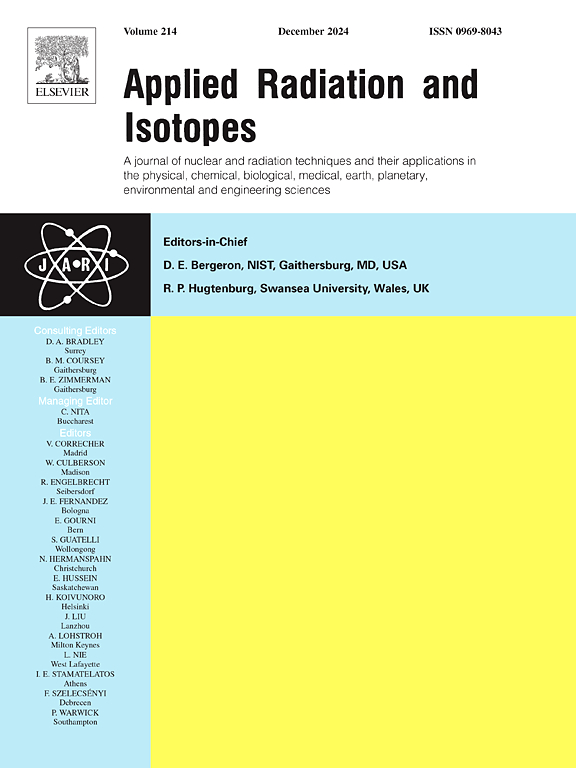Optimization of synthesis conditions of [68Ga]Ga-PSMA-D5 and its clinical application in prostate cancer
IF 1.6
3区 工程技术
Q3 CHEMISTRY, INORGANIC & NUCLEAR
引用次数: 0
Abstract
Radioisotope-labeled prostate-specific membrane antigen (PSMA) PET tracers have gained popularity in diagnosing prostate cancer (PCa). Recently, a novel biphenyl-containing tracer [68Ga]Ga-PSMA-D5 targeting PSMA has been developed for PET imaging of PCa. The advantages of [68Ga]Ga-PSMA-D5 include high tumor uptake, simple synthesis, and convenient labeling, making it a promising PSMA PET tracer. In order to facilitate the routine production and clinical application of [68Ga]Ga-PSMA-D5, a straightforward and efficient automated synthesis is described. The optimum labeling parameters were determined at laboratory scale, and subsequently incorporated into an automated production process. Further studies have demonstrated that clinical doses of [68Ga]Ga-PSMA-D5 can be prepared within 25 min, with excellent radio chemical purity (>99 %) and activity yield (70.8 % ± 2.3 %, non-decay corrected). All the quality control results satisfy the required criteria for release. PET/CT imaging has shown that [68Ga]Ga-PSMA-D5 can safely and effectively target prostate cancer-associated lesions with excellent tumor-to-background contrast. This methodology facilitates efficient synthesis of [68Ga]Ga-PSMA-D5 in a commercially available synthesis module and shows diagnostic value for PCa in further clinical application.
68Ga]Ga-PSMA-D5 的合成条件优化及其在前列腺癌中的临床应用
放射性同位素标记的前列腺特异性膜抗原(PSMA)PET示踪剂在诊断前列腺癌(PCa)方面越来越受欢迎。最近,一种新型含联苯的示踪剂[68Ga]Ga-PSMA-D5被开发用于PCa的PET成像。68Ga]Ga-PSMA-D5具有肿瘤摄取率高、合成简单、标记方便等优点,是一种很有前途的PSMA PET示踪剂。为了促进[68Ga]Ga-PSMA-D5的常规生产和临床应用,本文介绍了一种简单高效的自动化合成方法。在实验室规模确定了最佳标记参数,随后将其纳入自动化生产流程。进一步的研究表明,临床剂量的[68Ga]Ga-PSMA-D5可在25分钟内制备完成,并具有极佳的放射化学纯度(99%)和活性产率(70.8% ± 2.3%,非衰变校正)。所有质量控制结果均符合释放所需的标准。PET/CT 成像显示,[68Ga]Ga-PSMA-D5 可以安全有效地靶向前列腺癌相关病灶,具有极佳的肿瘤与背景对比度。该方法有助于在市售合成模块中高效合成[68Ga]Ga-PSMA-D5,并在进一步的临床应用中显示出对 PCa 的诊断价值。
本文章由计算机程序翻译,如有差异,请以英文原文为准。
求助全文
约1分钟内获得全文
求助全文
来源期刊

Applied Radiation and Isotopes
工程技术-核科学技术
CiteScore
3.00
自引率
12.50%
发文量
406
审稿时长
13.5 months
期刊介绍:
Applied Radiation and Isotopes provides a high quality medium for the publication of substantial, original and scientific and technological papers on the development and peaceful application of nuclear, radiation and radionuclide techniques in chemistry, physics, biochemistry, biology, medicine, security, engineering and in the earth, planetary and environmental sciences, all including dosimetry. Nuclear techniques are defined in the broadest sense and both experimental and theoretical papers are welcome. They include the development and use of α- and β-particles, X-rays and γ-rays, neutrons and other nuclear particles and radiations from all sources, including radionuclides, synchrotron sources, cyclotrons and reactors and from the natural environment.
The journal aims to publish papers with significance to an international audience, containing substantial novelty and scientific impact. The Editors reserve the rights to reject, with or without external review, papers that do not meet these criteria.
Papers dealing with radiation processing, i.e., where radiation is used to bring about a biological, chemical or physical change in a material, should be directed to our sister journal Radiation Physics and Chemistry.
 求助内容:
求助内容: 应助结果提醒方式:
应助结果提醒方式:


